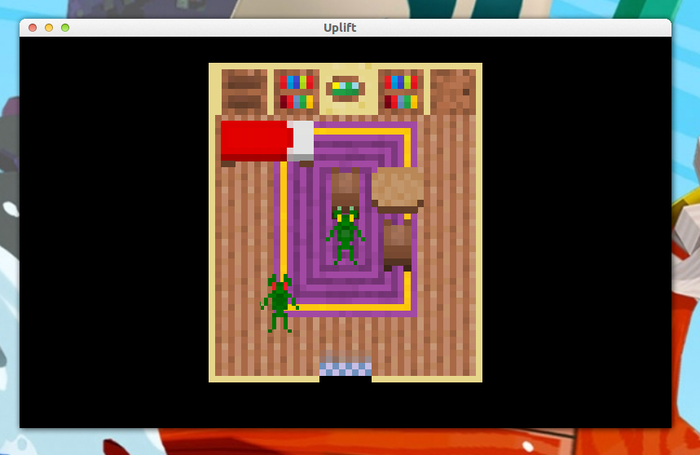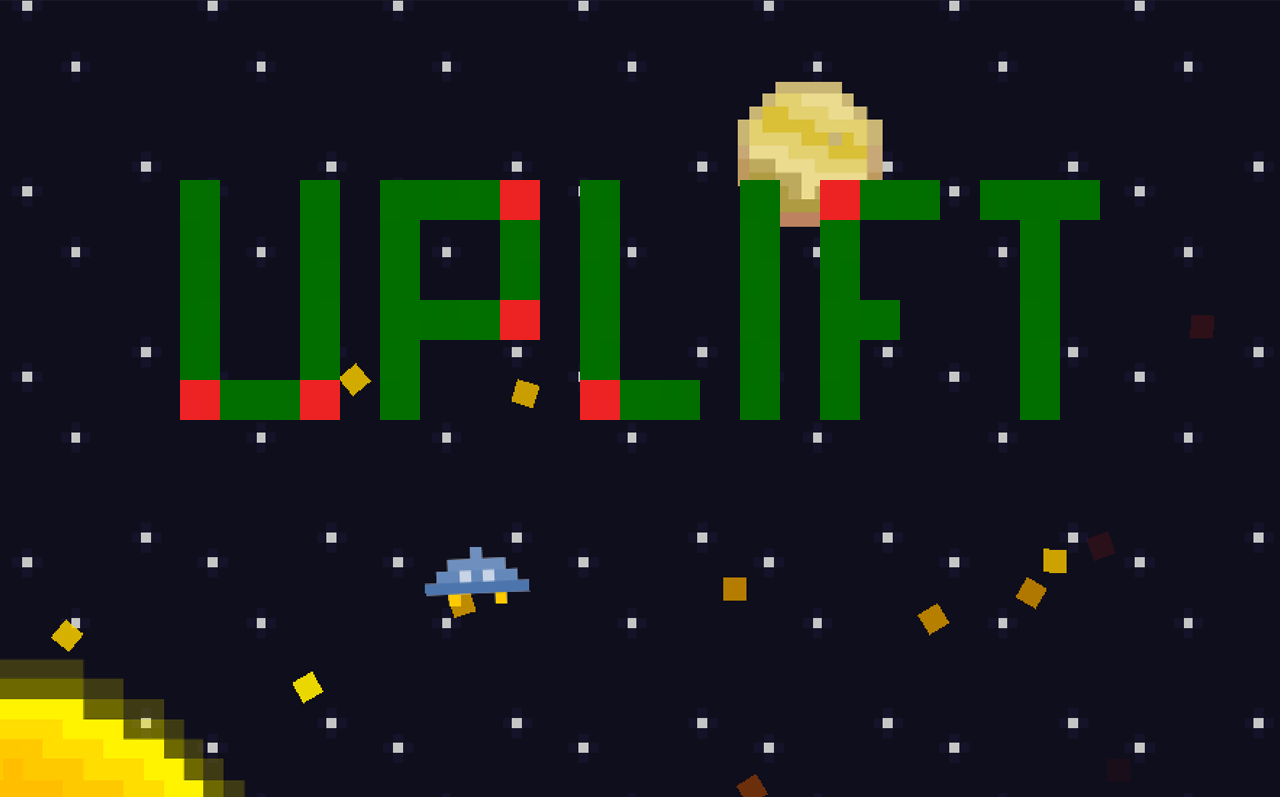Before I begin, I should point out: Uplift isn’t dead. The Kickstarter for Uplift is dead. Sensationalist title, I know. Let’s pretend I’ve been learning how to be a journalist. Because having a blog definitely makes me a journalist, right? Ahem.
Bearwaves launched a Kickstarter for our game, Uplift, on the 20th March, and we reached the deadline a couple of days ago, having raised £961 from 77 pledges. This is by no means a small amount of money or number of backers, and we’re actually really pleased with what we accomplished, and immensely grateful to everyone who supported us. However, it was a long way off our £8,000 goal. In this post I’m going to attempt to learn as much as I can from this failure, in the hope that it’ll help us as we move on with Uplift, and that it might prove of some help to any developers in the planning stages for their own Kickstarter project.
I’ll include some of my own observations, as well as some of the feedback we received from places like HackerNews. Some of this feedback was quite harsh, but I feel it’s all valid and important to internalise; this isn’t intended as any kind of pity-seeking operation.
I’ll focus first on the problems with the Kickstarter - lessons learned in hindsight. These aren’t necessarily useful to us now, as we’re unlikely to use crowdfunding again (at least for a long while). They may, however, be helpful for anyone looking for pitfalls in their own project - perhaps, if your own pitch has some of the same shortcomings ours did, you may be able to avoid making our mistakes. I’ll then focus on Uplift itself, and what changes we’re going to make moving forward. Here we go.
The Video
The video is the first thing you see when you land on a Kickstarter page, so it makes sense to analyse this first of all.
Our video wasn’t good enough. This much is obvious, and to be totally honest I think we knew this - that’s why we put so much effort into filling the text part with content. I could talk for ages about the poor lighting, shoddy cameras and dodgy shooting techniques that were used, but I’m not going to - we aren’t filmmakers, and we don’t have good equipment. I think a well-shot video is certainly very helpful, but it’s not going to dictate whether or not your hit your funding goal; thus, for now, I’ll only talk about the things we were capable of changing in ours.
The first and probably most important point to make is the order in which the footage was shown. Starting the video with ’talking heads’ - us introducing the game - is all very well and gives the project a more human feel. However, we should almost certainly have played the footage of the game much closer to the beginning. The video had just over 3,700 plays, with around 7% of viewers watching it the whole way through - this means there were very likely a few hundred people who lost interest in the video before seeing any footage of the game, or skipped past what we were saying to get to it. Explaining your project is great, but with a video game people want to see a video of the game - we didn’t deliver on this well enough.
Another issue was the game footage itself. I’m not going to comment here on how the game looks - that comes later - but rather what bits of it we chose to show. We’re billing Uplift as a game with:
- Exploration
- A ‘proper’ storyline
- RPG elements
- Puzzles
We showed a little bit of the space flight, and some footage of the player walking around. That was pretty much it - we therefore demonstrated a tiny amount of exploration, and none of the other three points. Annoyingly, in hindsight, NPC interaction and the quest log are some things we’ve already built into the game, but weren’t included in the footage as we didn’t think they would look good or work well in a video. That was another mistake - when you show footage of a role-playing game, potential customers want to see some role-playing.
Another piece of feedback given to us was that we didn’t seem enthusiastic in the video. I’m not quite sure how to take this one - granted, we weren’t quite ourselves as none of us are used to talking to cameras, but I don’t think we were excessively wooden. I suppose (to make a sweeping generalisation) we Northern Irish can seem a bit more subdued; I guess this one’s more dependant on who you are and who your audience is.
The game was too incomplete
This one seems a little counterintuitive - surely Kickstarter is for uncompleted projects? The rules on the platform state that for a project to be given the go-ahead you need some kind of proof that you’re both working on it and capable of finishing it. We met the requirements of Kickstarter itself, but not those of our potential backers.
We’ve been working on Uplift since May 2012. That seems like a long time, but in reality ‘working on’ has meant ‘sporadically committing code and assets whenever we get the chance, along with totally rewriting the game from scratch after a year’. To us, of course, this makes perfect sense - we’re students, we’re very busy, we don’t have a budget and we just don’t have time to work consistently on the game. Indeed, that’s what the purpose of the Kickstarter was. To a potential backer, though, unless reading very carefully, this merely makes us look lazy and/or incompetent. We know we’re capable of creating this game, given some free time - after all, we know our own skillsets - but we didn’t give enough proof of this to potential backers.
It certainly didn’t help that a lot of the work done so far on Uplift has gone into the game’s backend - we have a fairly comprehensive system in place for level designing, building quests and creating NPCs with their associated dialogue. This means that actually building levels and characters into the game can largely be done without writing any code - great for us, but the result is that we simply didn’t have much user-facing stuff we could show off; ideally we should have had some kind of playable demo. We did have our old Android build, but it’s rather outdated, and if we’re marketing a multi-platform game, there should be a multi-platform demo to go along with it. Some more screenshots and footage would have not gone amiss either.
The pre-launch
One piece of feedback we were given, that we hadn’t quite taken into consideration before, was that we didn’t do enough to promote the Kickstarter project before its launch. We had a Facebook page with a couple of hundred ’likes’, and we posted it there, but the majority of people who had liked the page were friends of ours and so would have seen it anyway. Building some kind of community before launch isn’t necessarily essential - I’m sure there are many projects which have built their community post-launch - but it can’t hurt.
There are, of course, several other things we could have done better on the Kickstarter. Perhaps a better justification of why people would want the game, or what’s special about it. Perhaps we should have got a proper artist for those sketches instead of just getting a mate who likes to draw to do them. At the end of the day, the Kickstarter was amateurish because we are amateurs - which is fine, but it doesn’t necessarily mean people will want to give us their hard-earned cash.
With the feedback we got, we’ve learned of a few changes we could potentially make to Uplift itself as we move forward.
The graphics
 {: .center-image}
{: .center-image}
Uplift’s graphics are kind of sort of not very good. There’s no point um-ing and ah-ing around this issue; it needs to be addressed.
Personally, I quite like the very simplistic, pixelated style of the game. It keeps our filesize down, and requires a very small amount of memory at runtime, meaning the game performs well on even old hardware. It’s not ugly, by any stretch of the imagination. However, it’s very easy to see that the game simply doesn’t look good enough to be a modern PC game (even an ‘indie’ game). This isn’t the fault of Matthew, who is a coder by trade anyway, but rather is the fault of our very slow development rate.
When we started making Uplift, it was to be Android-only, and our reference device (“it should run well on this as a minimum”) was the original HTC Desire, which had a 1GHz, single-core CPU - not quite completely redundant at the time, but absolutely feeble nowadays. We even took steps to make sure the game would run on the HTC Wildfire - a phone that simply no-one would even attempt to play games on any more. Our simple graphical style was perfect then, but now, two years later, we’re targeting devices with multiple cores, double the clock speed and well over twice the screen resolution - and that’s just the mobile version. If our game is going to work at all on PC, or even modern mobile devices, the graphics need to be totally revamped, whether that’s with a higher level of detail or a different style entirely.
This presents us with a problem - Matthew is a pretty good artist, but it’s not his primary focus, and will likely be too busy to contribute much once he graduates. We’re waiting to see what he comes up with as a concept for a redesign, but if you’re interested, we are looking for graphics artists. Get in touch!
The game is too static
When you explore Uplift’s environments, they’re not terribly dynamic or immersive. We’ve got some cool particle effects on the stars in space, and NPCs do turn around to speak to you, but along with the enemies that’s pretty much it. We had planned to add a bit more life to the environments anyway, but the feedback has shown us just how important this is. The game can look great and have a great story, but if it doesn’t feel great or play well it won’t be a good game. Uplift is supposed to be immersive in terms of a great plot and big universe, but if that universe feels devoid of life it won’t be immersive in the slightest.
So what’s next?
Uplift’s not going away. This Kickstarter has just made us even more keen to get back to work on the game, and now that we’re not tied down with how much funding we receive, we can add more people to the team. Development will be slow, given that most of us are working through the summer, but there should be time to get quite a bit done. We’ll try to communicate as much as possible, so that everyone can track development as it progresses.
If you’re about to embark on your own Kickstarter adventure, I hope you’ve found this at least a little bit useful - and from all of us here at Bearwaves, good luck! Even if you don’t succeed, it’s a massively valuable experience and actually pretty fun. Do let us know how it goes!
If you’re interested in Uplift, I hope this has satisfied your curiosity a bit as to what’s going to happen to the project. Keep an eye on this blog or our Facebook page - there’ll be more news along soon!

